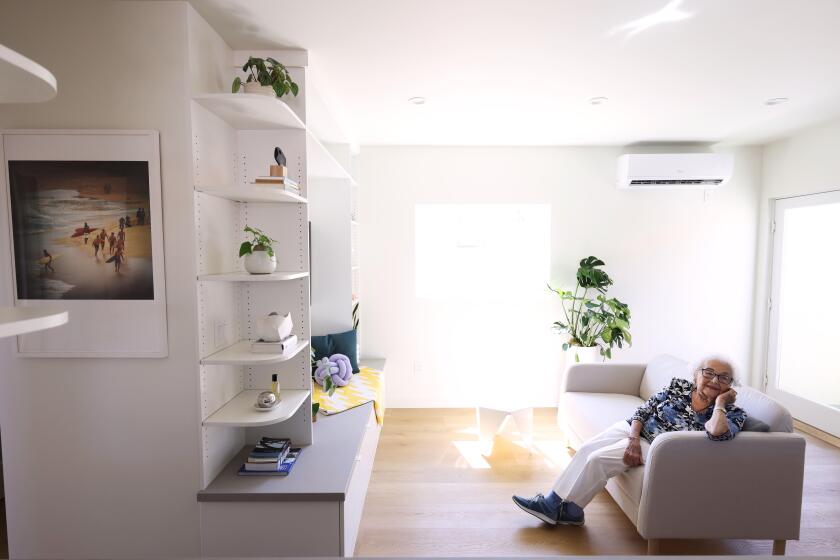A Cottage of Monumental Status
WASHINGTON — Paying homage to a largely forgotten historic treasure, President Clinton on Friday dedicated as a national monument the 158-year-old house that Abraham Lincoln used as a presidential retreat during the dark days of the Civil War.
In a ceremony on the lawn of the property, Clinton pledged $1.1 million to restore Anderson Cottage, which lies three miles from the White House on a hilltop estate that now serves as a retirement home for veterans.
“There is fragile, vital history in this house,” Clinton told about 200 retired veterans and their families. “Today, we come to claim it.”
Under a blazing sun, the veterans--many donning cone-shaped hats fashioned from newspapers--listened raptly as Clinton spoke. They chuckled when he said that, during his tour of the house just before the dedication, he became the first president since Chester Arthur to climb the stairs.
For Lincoln, who often traveled to the “Soldiers’ Home” by night on horseback, the cottage offered refuge from the crowded environs of 1600 Pennsylvania Ave.
As Clinton noted, Lincoln prepared the second draft of his Emancipation Proclamation, which freed slaves in seceding states, in a second-story bedroom, and he often read poetry in the shade of a great copper beech tree behind the house.
The 300-year-old tree, Clinton said, is therefore “the last living link to Abraham Lincoln.”
Clinton also recounted how, one evening in August 1864, the sound of a gunshot sent Lincoln flying as he traveled to the cottage. Although the president arrived safely, his hat was later discovered lying on the road with a bullet hole.
Two of Lincoln’s predecessors--Presidents Pierce and Buchanan--and three of his successors--Grant, Hayes and Arthur--also used the sizable stucco house, which originally belonged to George W. Riggs, a prominent Washington banker.
When the Army purchased the 8-year-old house from Riggs in 1851, it was named after Maj. Robert Anderson, who commanded Ft. Sumter at the outbreak of the Civil War. Since then, it has been part of a 320-acre residential veterans’ complex, now known as the U.S. Soldiers’ and Airmen’s Home.
Clinton was joined at the ceremony by Interior Secretary Bruce Babbitt, National Park Service Director Robert Stanton and Donald Hilbert, director of the U.S. Soldiers’ and Airmen’s Home, and members of the Washington City Council.
Army Master Sgt. William D. Woods, a 69-year-old retired veteran who lives at the veterans’ home and directs the White House Mail Room Annex there, introduced Clinton, expressing pride and gratitude on behalf of his fellow residents, who, he said, are delighted that a historic structure they have long treasured will be preserved and restored.
“It is now going to become one of the sights in D.C.,” said Ralston E. Patten, a retired member of the 82nd Airborne Division and a six-year resident of the home. “People will come out to see it.”
Local politicians echoed Patten’s prediction of a tourist-filled future for Anderson Cottage in its new incarnation as the President Lincoln and Soldiers’ Home National Monument.
“We’re ecstatic,” said Washington City Councilwoman Charlene Drew Jarvis.
“Part of what we want tourists to do is leave the monument ring on the Mall and see other neighborhoods,” said Linda Cropp, the council’s chairwoman. “This site will bring them out into a residential area of the city.”
Clinton noted that last year 1 million people toured Ford’s Theatre, where Lincoln was fatally shot, but only 100 visitors made it to Anderson Cottage.
According to Richard Moe, president of the National Trust for Historic Preservation, the cottage eventually will become part of a research center for the study of the Lincoln presidency.
Clinton said that he was exercising his authority under the Antiquities Act of 1906 to confer the status of national monument on a place of “natural splendor” or a site of “national import.”
The $1.1 million will come from a coalition of public- and private-sector sponsors of the White House Millennium Council’s Save America’s Treasures program.
More to Read
Sign up for Essential California
The most important California stories and recommendations in your inbox every morning.
You may occasionally receive promotional content from the Los Angeles Times.









